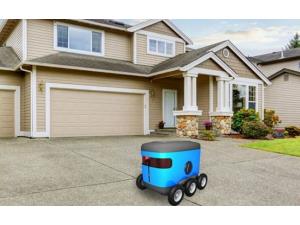



Date:23/01/20
 It's already possible for robots to navigate without maps, but having them navigate well is another matter. You don't want them to waste time backtracking, let alone fall down if they bump into an unexpected obstacle. Facebook might have a solution. It recently developed a distributed reinforcement learning algorithm that not only reaches its destination 99.9 percent of the time without using maps, but can do so with just a three percent deviation from the ideal path. DD-PPO (Decentrialized Distributed Proximal Policy Optimization), as it's called, doesn't need more than a standard RGB camera with depth data, GPS and a compass.
It's already possible for robots to navigate without maps, but having them navigate well is another matter. You don't want them to waste time backtracking, let alone fall down if they bump into an unexpected obstacle. Facebook might have a solution. It recently developed a distributed reinforcement learning algorithm that not only reaches its destination 99.9 percent of the time without using maps, but can do so with just a three percent deviation from the ideal path. DD-PPO (Decentrialized Distributed Proximal Policy Optimization), as it's called, doesn't need more than a standard RGB camera with depth data, GPS and a compass.
The trick was to implement a new training method that scaled well and stayed in sync no matter what the workload. Previous projects tend to struggle without massive computational power. Facebook taught a virtual agent to handle point-to-point navigation for the equivalent of 80 years of human experience -- that's about 2.5 billion steps. The result is an algorithm that, in indoor environments, is smart enough to choose the right fork in the path and quickly recognize errors when it does head in the wrong direction. It's learning to understand the "structural regularities" of buildings, Facebook speculated.
The technology is still very young. It has yet to handle outdoors or complex situations, and it doesn't handle long-distance navigation well if it has to lose sensors. Facebook is sharing its work in hopes of further advances, though. If that happens, it could not only help robots move gracefully from room to room, but help with augmented reality glasses and other systems that help you navigate unfamiliar spaces.
Facebooks new robot AI can get around efficiently without using a map
 It's already possible for robots to navigate without maps, but having them navigate well is another matter. You don't want them to waste time backtracking, let alone fall down if they bump into an unexpected obstacle. Facebook might have a solution. It recently developed a distributed reinforcement learning algorithm that not only reaches its destination 99.9 percent of the time without using maps, but can do so with just a three percent deviation from the ideal path. DD-PPO (Decentrialized Distributed Proximal Policy Optimization), as it's called, doesn't need more than a standard RGB camera with depth data, GPS and a compass.
It's already possible for robots to navigate without maps, but having them navigate well is another matter. You don't want them to waste time backtracking, let alone fall down if they bump into an unexpected obstacle. Facebook might have a solution. It recently developed a distributed reinforcement learning algorithm that not only reaches its destination 99.9 percent of the time without using maps, but can do so with just a three percent deviation from the ideal path. DD-PPO (Decentrialized Distributed Proximal Policy Optimization), as it's called, doesn't need more than a standard RGB camera with depth data, GPS and a compass.The trick was to implement a new training method that scaled well and stayed in sync no matter what the workload. Previous projects tend to struggle without massive computational power. Facebook taught a virtual agent to handle point-to-point navigation for the equivalent of 80 years of human experience -- that's about 2.5 billion steps. The result is an algorithm that, in indoor environments, is smart enough to choose the right fork in the path and quickly recognize errors when it does head in the wrong direction. It's learning to understand the "structural regularities" of buildings, Facebook speculated.
The technology is still very young. It has yet to handle outdoors or complex situations, and it doesn't handle long-distance navigation well if it has to lose sensors. Facebook is sharing its work in hopes of further advances, though. If that happens, it could not only help robots move gracefully from room to room, but help with augmented reality glasses and other systems that help you navigate unfamiliar spaces.
Views: 292
©ictnews.az. All rights reserved.Similar news
- Azerbaijani project to monitor disease via mobile phones
- Innovative educational system to be improved under presidential decree
- NTRC prolongs license of two TV and radio organizations for 6 years
- Azerbaijan establishes e-registry for medicines
- Azerbaijani museum introduces e-guide
- Nar Mobile opens “Nar Dunyasi” sales and service center in Siyazan city
- International conference on custom electronic services held in Baku
- OIC secretary general to attend COMSTECH meeting in Baku
- Azerbaijan develops earthquake warning system
- New law to regulate transition to digital broadcasting in Azerbaijan
- Azerbaijani State Social Protection Fund introduces electronic digital signature
- Intellectual traffic management system in Baku to be commissioned in December
- Tax Ministry of Azerbaijan started receiving video-addresses
- World Bank recommends Azerbaijan to speed up e-service introduction in real estate
- Azerbaijan to shift to electronic registration of real estate





















